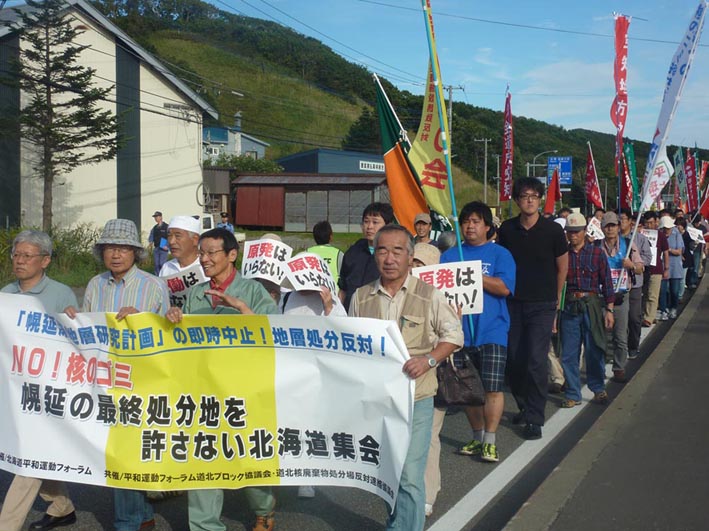by Representative, Northern Hokkaido Network against the Invitation of Nuclear Waste Disposal Facilities, Osamu Azuma

|
Rally against the Nuclear Waste Disposal Facility
|
In
Horonobe Town, Hokkaido, located in northern Japan at latitude 45º
north and longitude 141º 50’ east, the underground disposal of
high-level radioactive wastes resulting from the reprocessing of spent
fuel generated by nuclear power plants, is being studied. Horonobe is
the only place in Japan that hosts such a study.
Horonobe is a small town with a population of slightly more than 2,600.
In the early 1980s, the town initiated efforts to invite
nuclear-related industry to the area to halt the decline in population
and revitalize the town. The town succeeded in inviting the research
and storage facilities for high-level radioactive wastes in 1984.
However, the project was frozen due to strong opposition from
municipalities around the town and the Hokkaido population. As a
product of compromise, the Underground Research Project started in
April 2001 under the condition that no nuclear material would be
brought in and only research would be conducted. In the municipalities
around Horonobe, many citizen groups were established in the year when
the nuclear waste issue became a serious controversy, and in January
1985, the Northern Hokkaido Network against the Invitation of Nuclear
Waste Disposal Facilities was established as an organization networking
those groups. (Several such organizations were formed across Hokkaido.)
Japan’s first small experimental nuclear reactor was commissioned in
1957, and in 1976, the Nuclear Fuel Cycle Project, which planned to
produce plutonium and use it as fuel, became the core of Japanese
nuclear policy. However, the issue of disposal of high-level nuclear
wastes, which result from the nuclear fuel cycle, has remained
unresolved. In 2000, it was determined that the wastes would be
disposed of deep underground. The project has proceeded to date without
determining the details of waste disposal.
Soon after the Great East Japan Earthquake of March 11, 2011, neighboring three
reactors out of six at Fukushima Daiichi Nuclear Power Station
suffered meltdowns. It was the world’s worst ever industrial accident.
Today, as a result, none of nuclear reactors of the 54 that existed in
Japan before March 2011 is in operation. Many people in this country
are against the restart of nuclear reactors.
To determine the site for the disposal of nuclear wastes and thus
enable a swift restart for nuclear reactors, the government shifted the
disposal-site nomination system from a voluntary municipality
self-nomination system to a government designation system.
The deep underground research project in Horonobe Town has been
conducted based on an agreement that the research would be discontinued
in about twenty years. However, the Independent Administrative
Institution Japan Atomic Energy Agency (JAEA), which oversees the
project, has been attempting to extend this period, and has begun to
deny the agreement confirmed with local municipalities that the land
hollowed out for the underground facilities would be reclaimed after
the research had ended. There are still some people in Horonobe Town
voicing the opinion that nuclear waste disposal facilities should be
invited to the town. Concerns are growing that the town might be
designated to host the disposal facilities as a result of unreasonable
maneuvering of the project.
To make this situation that is occurring in Horonobe known nationwide,
the Northern Hokkaido Network against the Invitation of Nuclear Waste
Disposal Facilities began to hold the Horonobe Meeting for a Nationwide
Gathering on Nuclear Wastes in August 2009 in order to develop a voice
against the disposal facilities. In Japan, there are many active
volcanoes, earthquakes are frequent, and underground water is abundant.
Scientists seriously question the viability of the underground disposal
method. Geologically speaking, the geological structure of Hokkaido is
rather new,
having been formed only about 100,000 years ago. The area around
Horonobe Town is still experiencing deformation and tectonic activity.
Below the surface in the area around Horonobe lie mudstones, which
contain large numbers of fissures and great amounts of underground
water. (The water includes both water from the ground surface and
fossiliferous seawater. The daily average drainage volume from the
underground research facilities between April 2012 and March 2013 was
310.4 cubic meters.) There are also gaseous emissions. That research
into the disposal of high-level radioactive wastes, which need to be
isolated for as long as 100,000 years, is being conducted in such a
place, indicates a fundamental problem with Japan’s nuclear power
policy.

